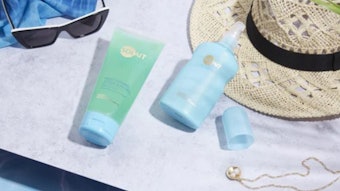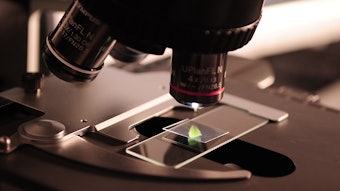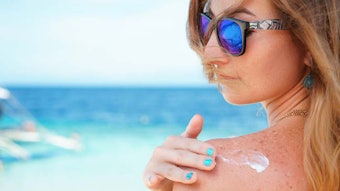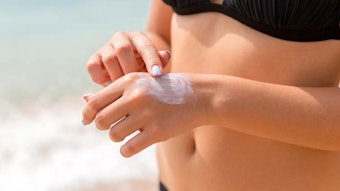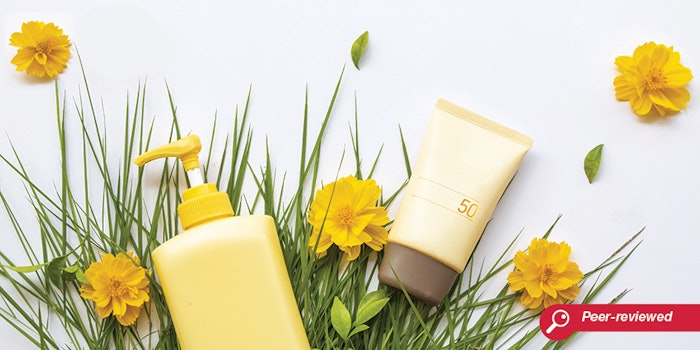
Read the full article in the April 2021 digital edition. . .
Rising public concerns for the environment have led to a higher demand for responsibly sourced and sustainable cosmetic ingredients. Furthermore, consumers expect products such as sunscreens to perform multiple functions—from providing highly effective UV protection and optimal water resistance, to feeling light and dry on the skin; all while remaining stable. However, many ingredients used to optimize the performance of sunscreens, such as SPF-boosters, film-formers and other synthetic and silicone-derived raw materials, have come under scrutiny due to sourcing, environmental, etc., concerns.
The formulator’s dilemma is therefore to find sustainably sourced alternatives to these ingredients without compromising performance, stability and aesthetics in the resulting product. Specific challenges formulators may face in developing sunscreens include the following:
• High-SPF sunscreen emulsions require higher levels of oil, electrolytes and pigments. This can lead to instabilities in the final product.
• A lack of film-forming and/or uneven droplet distribution can prevent UV filters from providing their full protection capacity.
• Skin feel and texture can be negatively affected by high oil content. In relation, film-forming products promising to retain water resistance can lead to a tacky or dull sensation on skin, which may decrease consumer acceptance and expectations.
• The water resistance of sunscreen emulsions can be negatively impacted by the higher emulsifier concentrations required to achieve stable formulations.
• The desire for more natural sunscreens seeks to exclude or reduce synthetic or silicone-based ingredients wherever possible.
To address these challenges, a multifunctional blenda was developed based on beeswax and a naturally derived anionic lactic acid ester, whose use in formulas can enhance the Natural Origin Content (according to ISO 16128).1, 2 Both materials are globally approved, biodegradable and based on 100% renewable sources, providing a versatile and sustainable option for modern sunscreens. Various tests, described herein, explored the ability of this blend to boost SPF, contribute to homogenous droplet distribution in emulsions, improve water resistance, form an even film on skin and maintain formula stability—all while imparting consumer-acceptable esthetics.
In vivo SPF Performance
Reaching the desired sun protection factor can be a challenge depending on the formulation and the chosen UV filters. Thus, to evaluate the effects of the natural blend on SPF in vivo, sunscreen emulsions with sun protection factors from 20 to 50+ were developed using different levels of the blend and compared with placebo formulations. Varying formulation bases and UV filter combinations also were tested.
The SPFs were determined by different independent and accredited institutes, measured according to ISO 24444:2010, with the SPF determined on a reduced indicative panel of 5-6 subjects.3 These results indicated the emulsions incorporating the multifunctional blend provided in vivo SPFs that were 10-27% higher than their respective placebo formulation, at confidence intervals from 9.3-20.2%. These results were promising and deemed acceptable for screening with a reduced panel, given that ISO 24444:2010 defines a maximum ±17% confidence interval as sufficient for a full test on at least 10 subjects.
. . .Read more in the April 2021 digital edition. . .
References:
- ISO 16128-1:2016 Guidelines on technical definitions and criteria for natural and organic cosmetic ingredients and products—Part 1: Definitions for ingredients. (2016). International Organization for Standardization (ISO). https://www.iso.org/standard/62503.html
- ISO 16128-2:2017 Cosmetics —guidelines on technical definitions and criteria for natural and organic cosmetic ingredients—Part 2: Criteria for ingredients and products. (2017). International Organization for Standardization (ISO). https://www.iso.org/standard/65197.html
- ISO 24444:2010 cosmetics—sun protection test methods—in vivo determination of the sun protection factor (SPF) (2010). International Organization for Standardization (ISO). https://www.iso.org/standard/46523.html
Captions/Footnotes:
a SymEffect Sun (INCI: Cera Alba (and) Sodium Stearoyl Lactylate) is a product of Symrise.

!['[Sunscreen] developers will be able to innovate more efficiently while maintaining high standards of quality and safety for consumers.'](https://img.cosmeticsandtoiletries.com/files/base/allured/all/image/2024/06/woman_outside_using_sunscreen_on_face_ISO_test_standards_AdobeStock_783608310.66678a92029d9.png?auto=format%2Ccompress&fit=crop&h=191&q=70&rect=62%2C0%2C2135%2C1200&w=340)



